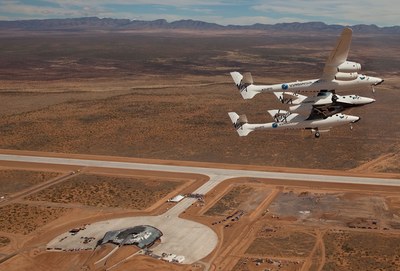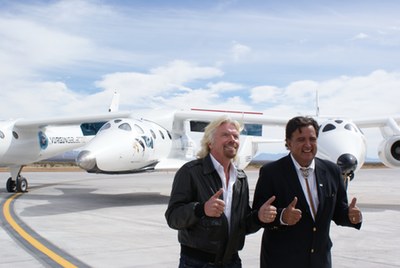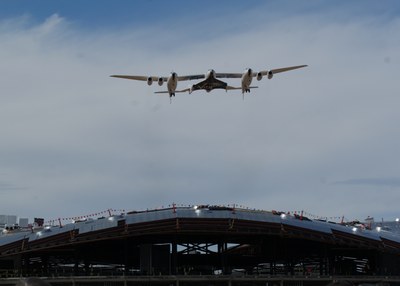A spaceport takes shapeby Jeff Foust
|
| “The ten thousand feet of runway that you see mark the pathway to commercial space development in New Mexico,” said Hynes. |
That’s the challenge faced by Spaceport America, the new commercial spaceport under construction in southern New Mexico. The same attributes that make the site ideal for hosting spaceflights—wide-open spaces and protected airspace—make it difficult to demonstrate the progress to date building it. How, then, do you show taxpayers, who are footing the bill for the $200-million facility, where their money is going? For state officials and the spaceport’s primary tenant, Virgin Galactic, one answer is to hold an event to show off the site and the vehicle that will eventually call the spaceport home.
A pathway for commercial space
Friday’s event at Spaceport America was officially billed as a “runway dedication”, marking the completion of the 10,000-foot (3,000-meter) runway that is the largest single component of the new spaceport. That runway, ironically, was off-limits and largely out of direct view of the event’s several hundred attendees, who gathered on a taxiway connecting the runway to the under-construction terminal building for a series of speeches and spectacles.
State officials played up the benefits that the spaceport will have for the region. “The ten thousand feet of runway that you see mark the pathway to commercial space development in New Mexico,” said Pat Hynes, director of the New Mexico Space Grant Consortium, in a speech at the event.
“Spaceport America is all about our future,” said New Mexico governor Bill Richardson, another speaker at the dedication. “It’s about jobs, it’s about technology, it’s about helping people create new challenges and fulfill needs.”
Richardson painted a robust future for the spaceport, seeing it hosting in ten years’ time everything from point-to-point suborbital spacecraft to orbital vehicles with flyback boosters, supporting missions going far beyond space tourism such as the study of the Earth and the universe. He also expected the spaceport to create thousands of jobs in the state and provide a reason for the state’s youth to remain in New Mexico. “Our greatest export, I have said, is our young people. I hope this industry will help to bring New Mexico’s children home.”
“Governor Richardson, you and I stood five years ago and shook hands on a simple pledge,” recalled Sir Richard Branson: the state would build the spaceport and Virgin would headquarter its operations there. “You’ve kept your word, and I like to say I’ve kept my end of the bargain as well.”
That was the prelude to the main event of the ceremony: a flyover by Virgin Galactic’s WhiteKnightTwo (WK2) carrier aircraft, with the SpaceShipTwo (SS2) suborbital spacecraft attached between the plane’s twin fuselages. For nearly a half-hour the aircraft swooped over the spaceport, making passes low over the runway and soaring above the terminal building, to cheers and applause from the audience.
| “We’re in a very complex part of the project right now, which is moving from a construction project to an operational spaceport,” said Homans. |
Event organizers, though, had one more thing up their sleeve. After WK2 and SS2 made their final pass over the spaceport and flew away, Richardson, Branson, and others started a press conference. Less than ten minutes later, though, Branson interrupted the proceedings. “I rang the pilot of the spaceship and said, ‘Look, we’ve got a runway here. Why are you going back to Mojave? Why can’t you come and sort of show it off?’ I’m not sure I managed to persuade him, but maybe we could all sort of put some vibes up in the sky.” What followed was the odd spectacle of several hundred people shaking their hands, clapping, and stomping their feet, all at the insistence of Branson, to try and get WK2 and SS2 to return.
At first nothing happened, and the press conference resumed. Several minutes later, though, he again called on the audience to clap and cheer and, sure enough, the aircraft returned to the skies, this time to land on the runway and taxi up near the stage for a round of photo ops with Branson and Richardson.
 An aerial shot of WK2/SS2 flying above Spaceport America. The terminal building is at bottom left. (credit: Mark Greenberg/Virgin Galactic) |
Building a spaceport
The event was billed by some as the grand opening for the spaceport, but that is a misnomer in two respects. One is that the site itself has already carried out several suborbital sounding rocket launches for UP Aerospace (the spaceport’s web site notes in its logo that it has been “providing launch services since 2006”.) Later this year Armadillo Aerospace is scheduled to being a series of flight tests of its vertical-launch, vertical-landing vehicle prototypes, supported by NASA’s Commercial Resuable Suborbital Research (CRuSR) program.
The second, and arguably bigger, issue is that while the spaceport’s runway is complete, other key elements of the spaceport facilities that will be used by Virgin Galactic are still under construction. Hynes, in remarks opening the International Symposium for Personal and Commercial Spaceflight (ISPCS) in Las Cruces last week, described the spaceport as “60 percent complete”. The large Terminal Hangar Facility, which will serve as both a hangar for WK2 and SS2 vehicles as well as a terminal for Virgin’s customers and a mission control, is taking shape with the exterior structure and roof largely in place, but the building’s interior and even its exterior walls remain unfinished.
However, spaceport officials are looking ahead to getting ready for operations. “We’re in a very complex part of the project right now, which is moving from a construction project to an operational spaceport,” Rick Homans, executive director of the New Mexico Spaceport Authority, said in a presentation at ISPCS on Thursday. To that end, the authority is planning to release a number of requests for proposals later this year to handle those operational issues, ranging from maintenance to security. The authority is also actively recruiting for a deputy director who will handle the operational issues with the spaceport, a position Homans called “one of the plum jobs” for someone with spaceflight operations experience.
| “Obviously we want to move on to orbital after we’ve got suborbital under our belts, and maybe even before that,” Branson said. “Virgin Galactic is going to put forward proposals, and we plan to start work on an orbital program quite quickly.” |
Another aspect of planning for the spaceport is dealing with the influx of visitors anticipated when flights begin. Earlier this month the authority issued a request for information for visitor services. That RFI estimates that visitor traffic to the spaceport could be heavy: as many as 562,000 people a year, which would make the spaceport the third most-visited attraction in the state, behind only Carlsbad Caverns and White Sands.
“We recognize that the spaceport is going to be a huge draw for visitors to New Mexico,” Homans said in an interview last week. “We need to think through very carefully what is the experience: how is a visitor going to get to Spaceport America, and what are they going to see and do and feel once they get there.”
In the interview, Homans emphasized the need to be in sync with Virgin Galactic and said the spaceport authority has been closely working with the company to ensure that the spaceport facilities and capabilities match up with the company’s operational requirements. “We need to understand their operations completely, so that we build a facility where they can plug their operations into it,” he said. That cooperation is primarily done now through a series of three-day meetings, held quarterly, but Homans said that at some point next year the spaceport authority will move its offices from Las Cruces to the spaceport to be in even closer contact with Virgin. “It’s important that our center of gravity shift and that we are working every single day at the spaceport and dealing with spaceport issues,” he said.
Homans said that they planned to “substantially complete the infrastructure” at the spaceport by the second quarter of next year, although there would be additional work on other aspects of the facility, such as upgrades to the vertical launch facility several miles from the terminal and runway.
In an interview Friday at Spaceport America, Mark Butler, the project manager for spaceports for Virgin Galactic, said he expected the terminal building to be completed by the middle of next year, which will be followed by some “additional fit-out work” by Virgin. “We got probably, in terms of work on the building, about another 12 to 18 months; 12 months, really,” he said.
Virgin’s interest beyond suborbital
While work on the spaceport continues over the next year, Virgin Galactic and Scaled Composites will continue testing of WhiteKnightTwo and SpaceShipTwo. The companies achieved a milestone earlier this month with the first SS2 glide test in Mojave, California, part of what Virgin Galactic CEO George Whitesides called an “ambitious test schedule” for the program.
Virgin, as typical for them, shied away from specific timelines or schedules for bringing the system into service, although Branson said it would be “somewhere between 9 and 18 months” before commercial flights began at Spaceport America. That schedule, he said, would be dependent on the outcome of the extensive test program planned, including additional glide tests and powered test flights. “If you’re building a commercial spaceship program, you’ve got to offer return tickets,” he quipped. “So we just want to be absolutely sure we’ve got the program absolutely right; we’re giving ourselves the flexibility not to be rushed.”
| “We’ve come such a long way in five short years. I couldn’t be more proud for my state,” said Richardson. |
Virgin officials offered few other new details about the test program, including work on a rocket motor that will power SS2 on its suborbital flights. However, Virgin Galactic president Will Whitehorn did mention that besides the baseline hybrid rocket motor design, which uses nitrous oxide and rubber as propellants, the company was studying an alternative that replaces the rubber fuel with “basically, recycled nylon” that would reduce carbon emissions. He didn’t indicate if the company was actively testing that alternative concept.
Even though the suborbital SS2 won’t be flying into space until most likely some time next year, Branson indicated that the company was actively studying orbital concepts, perhaps to serve NASA’s interest in commercial vehicles to transport crews to and from the International Space Station. “Obviously we want to move on to orbital after we’ve got suborbital under our belts, and maybe even before that,” he said. Referring to the impending release of a NASA call for proposals for a second round of Commercial Crew Development (CCDev) awards, he added that “Virgin Galactic is going to put forward proposals, and we plan to start work on an orbital program quite quickly.” Branson declined to provide any details on Virgin’s orbital vehicle plans, but said the company would say more in the next three to four months.
 Sir Richard Branson and New Mexico governor Bill Richardson pose in front of WhiteKnightTwo and SpaceShipTwo at Spaceport America. (credit: J. Foust) |
Farewells and new beginnings
One other aspect of the ceremony, beyond highlighting the progress to date on the facility and the plans for the future, was recognizing Gov. Richardson for his support for the concept, dating back to his campaign for governor in 2002. “Without this man we would not be standing here today,” Homans said at Friday’s dedication. In recognition of that, the spaceport board of directors announced that the newly-dedicated runway would be officially known as the “Governor Bill Richardson Spaceway”.
“We’ve come such a long way in five short years. I couldn’t be more proud for my state,” said Richardson, who is leaving office at the end of the year because of term limits. “One of the things I wanted to see was a first flight while I was still governor,” he said later. “We haven’t exactly made that, but it’s close, and every other deadline has been met.”
With Richardson’s departure, the spaceport will be losing a patron who helped secure support and funding from the state legislature in 2006, shortly after announcing the partnership with Virgin. Homans, in last week’s interview, said he was not concerned about any lack of support from Richardson’s successor: Diane Denish, the current lieutenant governor and the Democratic nominee, has served on the spaceport board, and Homans said he’s briefed Susana Martinez, the Republican candidate. “I think they both understand that this is all about jobs and opportunity,” he said.
Homans himself returned to the spaceport project earlier this year, after having helped support it as the state’s secretary of economic development when the Virgin partnership was announced five years ago; in the interim he worked in the private sector and served as secretary of the state’s taxation and revenue department. “The further I got from the project, the more I realized how I missed it,” he explained. “I realized opportunities like this don’t come up very often in one’s life.”
“It’s a really fun project,” he added. “As many hours that I put into this, as many weekends that I’m working, there are no regrets at all because it is such an amazing project.”
Note: additional images of Friday’s events are available.
